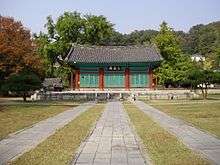Hyanggyo
The Hyanggyo were government-run provincial schools established separately during the Goryeo Dynasty (918-1392) and Joseon Dynasty (July 1392 - August 1910), but did not meet with widespread success in either dynasty. They were officially closed near the end of the Joseon Dynasty, in 1894, but many were reopened as public elementary schools in 1900.
| Hyanggyo | |
 Daeseongjeon Hall of Jeonju Hyanggyo in Jeonju, Jeollabuk-do. | |
| Korean name | |
|---|---|
| Hangul | 향교 |
| Hanja | |
| Revised Romanization | Hyanggyo |
| McCune–Reischauer | Hyanggyo |
In the Joseon Dynasty, hyanggyo were established in every bu, mok, daedohobu, dohobu, gun, and hyeon (the last corresponding roughly to the size of modern-day cities and counties). They served primarily the children of the yangban, or ruling elite upper-class. Education was oriented toward the gwageo, or national civil service examinations. Although such education was in high demand, the hyanggyo were ultimately unable to compete with the privately run seowon and seodang.
See also
| Wikimedia Commons has media related to Hyanggyo. |
- Daegu Hyanggyo
- Goheung Hyanggyo
- Gyeongju Hyanggyo
- Jeonju Hyanggyo
- Education in the Joseon Dynasty
- Seonggyungwan
- Seowon
- Ganghwa hyanggyo
References
- 향교 鄕校 [Hyanggyo] (in Korean). Nate / Encyclopedia of Korean Culture. Archived from the original on 2011-06-10.